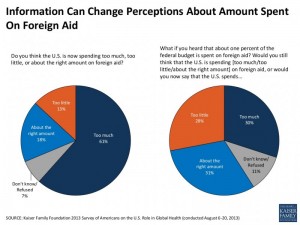Spending on foreign aid
It’s been a while since the last StatsChat bogus poll, so here’s a new one. Answer it before you read on
In many countries, the level of foreign aid is one of the great budget zombie statistics. A majority of people will say that foreign aid should be reduced, but if you ask them what percentage of the budget or of GDP it should be, a majority will quote a number at least as large as the current level
Ezra Klein goes over this topic again today using US figures. People were asked how much the US spends. The median estimate among those willing to give a figure was 21-30% of the federal budget. Even if you assume all the non-responders would have given a low value, the median estimate would still have to be 11-20%. It really isn’t that high. Not even close.
This is especially disappointing in the US, because the booklet with tax forms and instructions sent each year to basically everyone in the country shows in a pie chart (page 42) that defense, veterans, and foreign affairs in total account for 24% of the budget (and it’s pretty obvious that defense has got to be a substantial chunk of this) and actually says in the text that 1% is spent on international activities, including military and economic assistance to foreign countries and the maintenance of U.S. embassies abroad. Only 4% of people surveyed thought that foreign aid was less than 5% of the budget, putting a fairly strict upper bound on the number of people who look at that information.
One slightly promising finding is that people are not completely information-resistant on this topic. It’s not that they say ‘whatever it is, it’s too much’, as other survey results show (click to embiggen):
For New Zealand: expenditure in 2012 was $562 million, which is just over half a percent of the $91 billion total Crown expenditure for the year ending 30/6/2013.
Thomas Lumley (@tslumley) is Professor of Biostatistics at the University of Auckland. His research interests include semiparametric models, survey sampling, statistical computing, foundations of statistics, and whatever methodological problems his medical collaborators come up with. He also blogs at Biased and Inefficient See all posts by Thomas Lumley »

I agree that it’s good for citizens to have a rough idea of how much their governments spend on foreign aid, but I don’t agree with the idea that it’s bad that we don’t read the entire information booklet that comes with the 1040. The information about where the money goes is after all the instructions and tax tables. It’s even after the ridiculous part about the “paperwork reduction act.” By the time you’ve gotten there, the last thing you want do is read and remember some unnecessarily 3-dimensional pie chart about what your taxes are actually spent on. I would argue (only tongue-in-cheek) that people who actually read all the way to the end of that thing should get a hobby. (Maybe I’m just defensive because I had no idea that this information was included in the IRS packet.)
For what it’s worth, I got the question right in this poll and would have guessed between 1/2% and 1% for the US.
11 years ago
Yeah, I wasn’t entirely serious. But I do like the fact the information is in the 1040 instructions. And although it’s a 3-d pie chart, it’s still better presented than most of the other information in that booklet.
The other simple representation I liked was Paul Krugman’s (slightly obsolete now) summary of the budget as five roughly equal pieces: social security, medicare, interest on the debt, defense, and everything else.
11 years ago
I guessed 0.1% but I would have been shocked if it was over 1%. The era of direct war subsidies ended with Napoleon, so far as I recall. And those are the only way I can think of a nation state pushing up foreign aid to the high levels at the bottom of the chart (~15%)
11 years ago